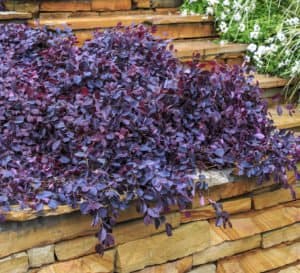Keep shrubs healthy and thriving by taking a little extra care during the hot summer months.

1. Prune your shrub’s dead weight and sucker sprouts.
Dead and dying foliage (leaves, flowers, and branches) generates additional heat and takes nutrients from the shrub, including much needed moisture from the soil. Sucklings growing at the base of the shrub also strip the shrub’s nutrients and water supply. By regularly pruning your shrub’s dead foliage and sucker sprouts, you’re improving your shrub’s appearance and ensuring that the healthy parts of the shrub get all the nutrients and water needed to survive the heat.

2. Watch the moisture level of the soil.
Especially during summer, it’s important to make sure the shrub’s soil stays moist (not soaking) and does not dry out. If the soil is dry, the shrub has already consumed available water and nutrients, which could lead to foliage shriveling and a weak root system. It’s best for the shrub to have a steady supply of water and nutrients to help guard against the demands of the sun and heat. Be careful, certain plants such as Loropetalums, are very sensitive to over-watering. Purple Pixie®, Purple Diamond®, and Emerald Snow® Loropetalums do not like soggy soils. Stick to a regular watering routine that keeps the soil moist, yet well-drained.

3. Water “deep” rather than more often.
Though the moisture level of the soil is important to maintain, let the water run deep to the roots rather than providing a surface-level sprinkle. By watering deep into the ground, you are allowing the roots to pull more water and nutrients from below the surface. This helps to establish a deeper root system for the shrub, thus protecting the shrub from intense heat and other weather conditions. If you are concerned about making the roots soggy – for example, Jubilation™ Gardenia may lose buds from over-watering or poor drainage – add peat moss to the soil and it will help retain some of the moisture.

4. Invest in mulch.
Mulch protects the shrub’s roots from the sun as well as provides additional moisture and nutrients. Spread mulch liberally so that the soil and exposed roots are covered from the sun. The layer of mulch will help keep the soil moist as it will be the first layer to absorb the sun and keep the moisture trapped below the surface for the roots.
5. Plant trees and vines.
If all else fails and the heat is just too much, try planting trees and vines to help shelter your shrubs. You can choose a small tree variety to shade smaller shrubs. For example, Blush Pink™ Nandina requires full sun, but some afternoon shade from a Delta Jazz® Crapemyrtle is beneficial in offering some escape from the extreme heat. Also, if you have shrubs growing next to your privacy fence or other wood shelters, plant vines to block the wood from absorbing and giving off additional heat.










